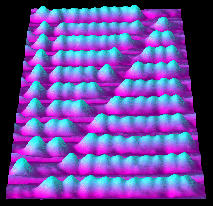Nanotech dreamsToby HowardThis article first appeared in Personal Computer World magazine, September 1998. HERE'S A DATE for your diary: November 1st, 2011. According to a group of researchers calling themselves the Nanocomputer Dream Team, that's the day they'll unveil a revolutionary kind of computer, the most powerful ever seen. Their "nanocomputer" will be made out of atoms. First suggested by Richard Feynman in 1959, the idea of "nanotechnology" -- constructing at the atomic level -- is now a major research topic worldwide. Theoreticians have already come up with designs for simple mechanical structures like bearings, hinges, gears and pumps, each made from a few collections of atoms. These currently exist only as computer simulations, and the race is on to fabricate the designs and prove that they can work. Moving individual atoms around at will sounds like fantasy, but it's already been demonstrated in the lab. In 1989, scientists at IBM used an electron microscope to shuffle 35 xenon atoms into the shape of their company's logo. Since then a team at IBM's Zurich labs has achieved the incredible feat of creating a working abacus on the atomic scale (see illustration).
Each bead is a single molecule of buckminsterfullerene (a "buckyball"), comprising 60 atoms of carbon linked into a football shape. The beads slide up and down a copper plate, nudged by the tip of an electron microscope . The Nanocomputer Dream Team wants to use these techniques to build an atomic computer. Such a computer, they say, can then be used to control simple molecular construction machines, which can then build more complex molecular devices, ultimately giving complete control of the molecular world. The driving force behind the Dream Team is Bill Spence, publisher of Nanotechnology magazine. Spence is convinced that the technology can be made to work, and has enlisted the help of over 300 enthusiasts with diverse backgrounds -- engineers, physicists, chemists, programmers, artificial intelligence researchers. The whole team has never met, and probably never will. They talk by email and pool their ideas on the Web. There's only one problem. Nobody is quite sure how to build a digital nanocomputer. The most promising idea is "rod logic", invented by nanotechnology pioneer Eric Drexler, now chairman of the leading nano think-tank The Foresight Institute. Rod logic uses stiff rods made from short chains of carbon atoms. Around each rod sits a "knob" made of a ring of atoms. The rods are fitted into an interlocking lattice, where each rod can slide between two positions, and be reset by a "spring" made of another few atoms. Drexler has shown how to use such an arrangement to achieve the effect of a conventional electronic transistor, where the flow of current in one wire is switched on and off by current in a different wire. Once you have transistors, you can build a NAND gate. From NAND gates you can construct every other logic element a computer needs. Apart from the immensely difficult problem of physically piecing together these molecular structures, massive calculations are required to determine if particular molecular configurations are even possible. The Dream Team will perform these molecular simulation calculations using "metacomputing" where each person's PC performs a tiny part of the overall calculation, and the results are collated on the Web (see June's Futures). There are already prototype tools for experimenting with molecular configurations, such as NanoCAD, a freeware nano design system including Java source code. This may all sound like pie in the sky, but there's serious research and development money being spent on nanotechnology. A recent survey counted over 200 companies and university research groups working in the field. And April 1997 saw the foundation of Zyvex, the world's first nanotechnology manufacturing company. Zyvex's goal is to build an "assembler", the basic element required for nanotechnology. The assembler will itself be a machine made from molecules, fitted with atom-sized tools for manipulating other molecules to build other machines. It will also be capable of replicating itself from the materials around it. While they may lack any actual working prototypes of their technology, nanotechnologists are certainly not short of ideas. Once you have the ability to make molecular machines, the possibilities are amazing -- and often bizarre. One idea is "utility fog", where billions of sub-microscopic molecular robots each containing a nanocomputer are linked together to form a solid mass. Controlled by a master nanocomputer, the robots could alter their configurations to create any object you like. Nanotechnology does come with one tiny drawback, however. What happens if a molecular machine goes haywire, and instead of building, starts demolishing the molecules around it? The world would -- quite literally -- fall apart. Nanocomputers, if they ever appear, will be extraordinary things. But if, like most computer systems, they have bugs, they could also be very nasty indeed. Toby Howard teaches at the University of Manchester. |
